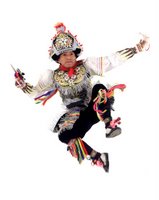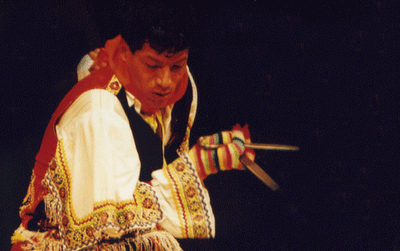Here "I offer another Arguedas from the one presented by the critical canon: an Arguedasmachine that 'nobody has observed.' This Arguedasmachine is hard at work fabricating a techno-indigenism that both separates and presses together the various elements of Peruvian culture [. . .] but it finally breaks down by becoming fully immanent to the affective flows on which it operates."
It's a draft, so all the usual caveats apply. But comments, questions, disputations, etc. would be most welcome. I'm not sure I like the conclusion, but there we go.
Meantime, here's a snippet, about one of Arguedas's most renowned short stories:
 The amount of attention that has been paid to one, late, story in particular, “La agonía de Rasu Ñiti,” is surely due to the fact that it is one of Arguedas’s very few texts that can at all convincingly be shoe-horned into a more or less conventional indigenist critical frame. But this is precisely a tale of the machinic transformation of affect. It concerns a traditional scissor dancer on his deathbed. The highland (specifically, Ayacuchan) scissor dance is, as its name suggests, an irreducibly hybrid performance--almost as much as that other ritual to which Arguedas endlessly returns, the “yawar fiesta” (or “festival of blood”) in which a condor is tied to the back of a bull in celebrations tied to Peru’s day of independence. But whereas the “yawar fiesta” brings together principally the Hispanic and the telluric (the bull) with the Inca and the ethereal (the condor), the scissor dance is above all a meeting of man with eminently modern technology. Scissor dancers perform either with actual scissors or, as Martin Lienhard reports, two oversize rods of iron or steel in the form of a pair of scissors. Lienhard goes on to say that the dancer’s use of these strange instruments “may have been a parodic representation of the arrogant Spaniard.” So while the dancers also “represent the wamanis--the mountains in so far as they are ‘divinities’ and forces that dispense water for the farmers’ fields” (Cultura andina 137), the use of these iron implements immediately conjures up the iron that, in the words of the fox from down below, “belches forth smoke and a little blood, making the brain burn, and the testicle too” (The Fox from Up Above 26). The scissors are an instrument of domestic labor, a sign of decadent Spanish fashion and (like Diego’s frockcoat) fashionable modernity, as well as a weapon, a threat of castration, a neutering that could threaten continued biological and cultural reproduction. The scissors are a machine that is, literally, double-edged.
The amount of attention that has been paid to one, late, story in particular, “La agonía de Rasu Ñiti,” is surely due to the fact that it is one of Arguedas’s very few texts that can at all convincingly be shoe-horned into a more or less conventional indigenist critical frame. But this is precisely a tale of the machinic transformation of affect. It concerns a traditional scissor dancer on his deathbed. The highland (specifically, Ayacuchan) scissor dance is, as its name suggests, an irreducibly hybrid performance--almost as much as that other ritual to which Arguedas endlessly returns, the “yawar fiesta” (or “festival of blood”) in which a condor is tied to the back of a bull in celebrations tied to Peru’s day of independence. But whereas the “yawar fiesta” brings together principally the Hispanic and the telluric (the bull) with the Inca and the ethereal (the condor), the scissor dance is above all a meeting of man with eminently modern technology. Scissor dancers perform either with actual scissors or, as Martin Lienhard reports, two oversize rods of iron or steel in the form of a pair of scissors. Lienhard goes on to say that the dancer’s use of these strange instruments “may have been a parodic representation of the arrogant Spaniard.” So while the dancers also “represent the wamanis--the mountains in so far as they are ‘divinities’ and forces that dispense water for the farmers’ fields” (Cultura andina 137), the use of these iron implements immediately conjures up the iron that, in the words of the fox from down below, “belches forth smoke and a little blood, making the brain burn, and the testicle too” (The Fox from Up Above 26). The scissors are an instrument of domestic labor, a sign of decadent Spanish fashion and (like Diego’s frockcoat) fashionable modernity, as well as a weapon, a threat of castration, a neutering that could threaten continued biological and cultural reproduction. The scissors are a machine that is, literally, double-edged.And the scissors are double-edged, too, in the sense that they join as well as cut. The scissors only function in so far as two elements come together; they cut only in that the two blades join. Every rupture, therefore, is equally a new conjunction or conjugation of forces uniting. Just as with the fishmeal factory’s centrifuges, separation also implies mixing, packing together, creating new combinations and new continuities. The importance of such conjugations and continuities is apparent in “La agonía de Rasu Ñiti,” on at least two axes. First, the dancer is himself the point of an intersection at which the natural, the divine, the human, and the industrial meet. He constitutes something like a conveyer, a means of transmission, between the wamani and the scissors. As his wife says to their daughter: “It’s not your father’s fingers that are working the scissors. It’s the wamani that brings them into contact. All your father does is obey” (475). The scissor dance channels energy from above to below; it is a power line, the dancer merely a transformer, converting energy from one form (the natural, divine) into another (the mechanical, but also aesthetic). In this transformative relay of energy, the dancer’s scissors are like the harpist’s “steel fingernail” that causes “the wire and gut strings to explode into sound” (476). Here it is wire, steel, animal gut, and the harpist’s hands that come together to produce the music accompanying and motivating the dance. But second, the dance is also a vital communicating vessel across another axis, the historical and communal. For the dancer’s role is pre-eminently social, “lighting up festivities in hundreds of villages” (474). And in this story he is passing on this power to a new generation. Rasu Ñiti dances his death agony--each component element of his body, first one leg, then another, then his arms, seizing up--only for his role to be taken over by the young dancer in waiting, Atok’ sayku. The old dancer lies on the floor, slowly paralyzed until his eyes alone reveal any trace of life and movement, but the young inheritor picks up the scissors and continues the dance: “It was him, father Rasu Ñiti, reborn, his sinews those of a gentle beast, imbued with fire from the wamani, whose centuries-old current continued to vibrate through him” (480). Finally, Rasu Ñiti’s eldest daughter can shout out “He’s not dead! Because it’s him! Dancing!” (480). At stake, as the man’s vital powers ebb away, as he hovers between death and life, is now what in very similar circumstances Deleuze terms “a life of pure immanence, neutral, beyond good and evil. [. . .] an immanent life carrying with it the events or singularities that are merely actualized in subjects and objects” (“Immanence: A Life” 29). And this life, indefinite and unqualified by the separation between subject and object, is characterized by a pure affect: “something soft and sweet” (“Immanence: A Life” 28); “pure power and even bliss” (30); for Arguedas, again the “yawar mayu,” the river as a flood of blood that carries all before it but is also the “final step that is a feature of every indigenous dance” (“La agonía de Rasu Ñiti” 478).

1 comment:
Want To Increase Your ClickBank Commissions And Traffic?
Bannerizer makes it easy for you to promote ClickBank products with banners, simply go to Bannerizer, and get the banner codes for your selected ClickBank products or use the Universal ClickBank Banner Rotator to promote all of the ClickBank products.
Post a Comment